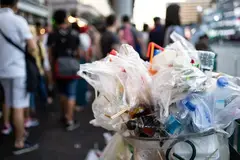INC-5.2: Plastics Europe circularity director urges recycled content targets in UN treaty
Recycled content targets, improved product design, and circular feedstock integration must be included in the UN Global Plastic Treaty currently negotiated in Geneva, Switzerland, according to Dr. Katharina Schlegel Thummer, circularity director at Plastics Europe.
The Belgium-based association supports an international legally binding instrument to end plastic pollution by 2040 that accelerates circularity, expands waste management access, and recognizes the diversity of national circumstances, while preserving the essential societal value that plastics provides, she tells Packaging Insights.
As the INC-5.2 negotiations continue, we sit down with Schlegel Thummer to discuss why the treaty presents a “once-in-a-generation opportunity to shape a circular economy globally.”
What is the most important aspect or topic to be included in the plastics treaty?
Schlegel Thummer: Transitioning to a circular plastics system, in which all plastics applications are reused, recycled, and responsibly managed, is the key to tackling the problem of plastic pollution and achieving a successful agreement. Recycled content targets, improved product design, and recognition of the role of circular feedstocks in ending plastic pollution are essential considerations. The most effective way to accelerate this transition, while supporting our sustainable development and climate change goals, is to ensure the agreement makes plastic waste a commodity with real value.
What are you expecting INC-5.2 to deliver?
Schlegel Thummer: The Global Plastic Treaty is a once-in-a-generation opportunity to shape a circular economy globally. We are calling for an ambitious and legally binding treaty with real-world impact to address plastic pollution, prioritising circularity with demand incentives, increasing access to waste management for 2.7 billion people worldwide, and promoting science-based and application-based approaches focusing on high-leakage and non-essential plastic products. Plastics Europe remains committed to working with the EU to help ensure the treaty enables the European industry to reclaim its leadership in circular plastics.  Schlegel Thummer stresses mandatory, time-bound recycled content targets are crucial to achieve circularity.
Schlegel Thummer stresses mandatory, time-bound recycled content targets are crucial to achieve circularity.
Additionally, Plastics Europe supports governments’ efforts to foster a sustainable consumption of plastic products and proposes an assessment tool that prioritises actions to reduce plastic pollution from problematic high-leakage applications. This criteria-based tool could be in the form of a decision tree. This would be designed to identify and address problematic and avoidable plastic applications, promoting a circular economy and a plastic-free environment.
What have the treaty negotiations established so far, up until INC-5.2?
Schlegel Thummer: While no final text was agreed upon at INC-5 in Busan, progress was made, including convergence in several articles of the chair’s non-paper, including those on product design and waste management.
How can international packaging circularity be achieved?
Schlegel Thummer: What we need is a strong global framework that gives clarity, aligns incentives, and helps scale solutions worldwide, including new technologies, recycling systems, and circular business models. Our priority is a treaty that sets clear direction, drives circularity, and enables tailored and implementable action plans in every country.
To achieve a circular economy for plastics, we need mandatory, time-bound recycled content targets to stimulate demand, unlock private sector investment, and enable circular value chains to scale. In Europe, especially, we need a single market for secondary raw materials (for example, EU-wide end-of-waste criteria), enablers to increase demand for secondary raw materials in finished products (for example, via mandatory recycled content targets in key legislations such as PPWR and End-of-life vehicles), and the promotion of circular raw materials via public procurement and other policy tools.
In regions with limited infrastructure, well-designed EPR schemes are another key enabler. They ensure that companies responsible for placing products on the market also finance their end-of-life management, while securing long-term financing for waste collection, sorting, and recycling, and can help integrate the informal sector.
The greater the economic value of plastic waste, the stronger the incentive to reuse and recycle, and to stop plastic from leaking into the environment. That’s how we’ll turn ambition into impact.  Plastics can be used for refill systems while allowing it to be recycled at their end of life, says Schlegel Thummer.
Plastics can be used for refill systems while allowing it to be recycled at their end of life, says Schlegel Thummer.
What role does cooperation play to establish packaging circularity?
Schlegel Thummer: Circularity for all applications is intrinsically a whole value chain activity, as no single part of the value chain controls all the levers for this transition. This is also true for packaging.
Effective collaboration between the plastics producers, converters, brands, the downstream value chain, and policymakers is essential to improve plastics circularity. Achieving packaging circularity requires strong, sustained collaboration between plastics producers, converters, brands, downstream users, recyclers, and policymakers. Each stakeholder plays a critical role in shaping systemic change — no one can do it alone.
Recognizing this, Plastics Europe and its members are actively engaging with partners across the value chain to drive progress. As part of this collaborative effort, the industry supports the introduction of a mandatory EU target of 30% recycled content in plastic packaging by 2030. This shared goal reflects our commitment to a circular economy and underscores the need for coordinated action across all sectors involved, whether at a national or global level.
Should the packaging industry continue to produce plastic?
Schlegel Thummer: The reality is that plastics will remain irreplaceable for many applications and sectors that underpin our modern world, from food protection to clean mobility, to healthcare, renewable energy, and aerospace. Plastics packaging is the largest end-use market due to its numerous benefits, thanks to its lightweight, durability, and barrier protection characteristics. It keeps food fresh, prevents spoilage, and reduces GHG footprint compared to heavier materials, providing essential societal value that we must make efforts to preserve.
However, we support the sustainable production and consumption of all plastics, including packaging, through circularity. This means that products are sustainably designed, produced, used, reused, and recycled instead of being discarded. Furthermore, by turning waste into feedstock and encouraging the use of circular feedstocks, we can reduce dependence on fossil fuels for plastics production.
In parallel, we believe that the treaty should address problematic and avoidable plastic applications locally through a science-based and application-based methodology, for example, in the form of a decision tree framework. This would enable countries to identify high-leakage, non-essential plastic applications and how to manage them while safeguarding essential uses.
In this way, the value of plastics, including plastic packaging, can be retained with the least impact on the climate.
How feasible is packaging reuse across packaging sectors?
Schlegel Thummer: In many instances, reuse (and refill) is an effective way of saving resources and improving the environmental footprint of our lifestyles. This general principle is currently applied in numerous applications, including plastic packaging. Thanks to their versatility and durability, plastics provide enormous potential for supporting reuse and refill systems in different applications while allowing for their return to the circular economy at their end of life.
A study commissioned by Plastics Europe, “ReShaping Plastics,” highlighted the potential of reuse systems and new delivery models covering different plastics uses and how they play a significant role in reducing both the emissions and waste from the plastics system. Plastics Europe supports measures to increase reuse of plastics through legislation and voluntary measures. Reuse targets for specific applications, like packaging, can be beneficial if they focus on products that contribute most to plastic waste.
However, reuse (and refill) systems should be assessed on an individual basis, considering design criteria as well as the environmental impact of their required supporting systems and processes. Individual assessments of their feasibility for different market sectors and products will be required, as these may well vary.











